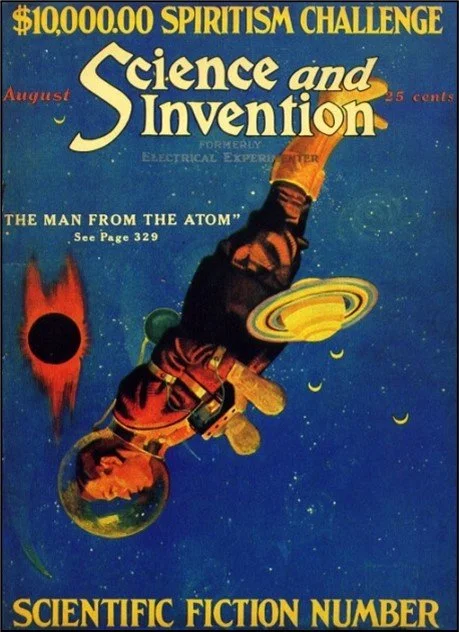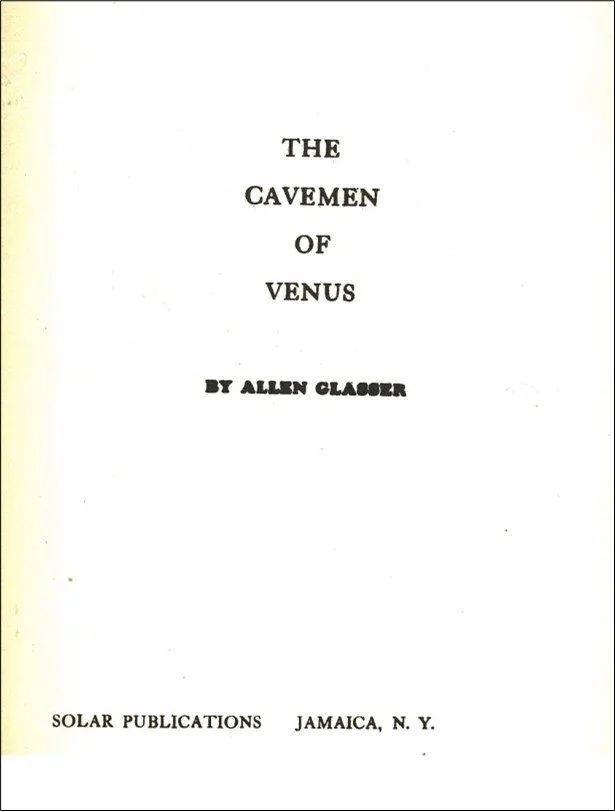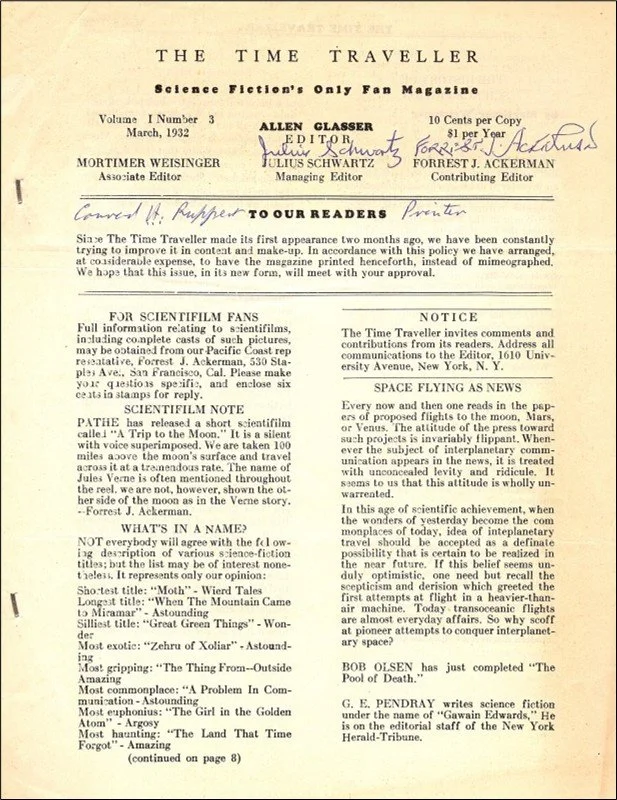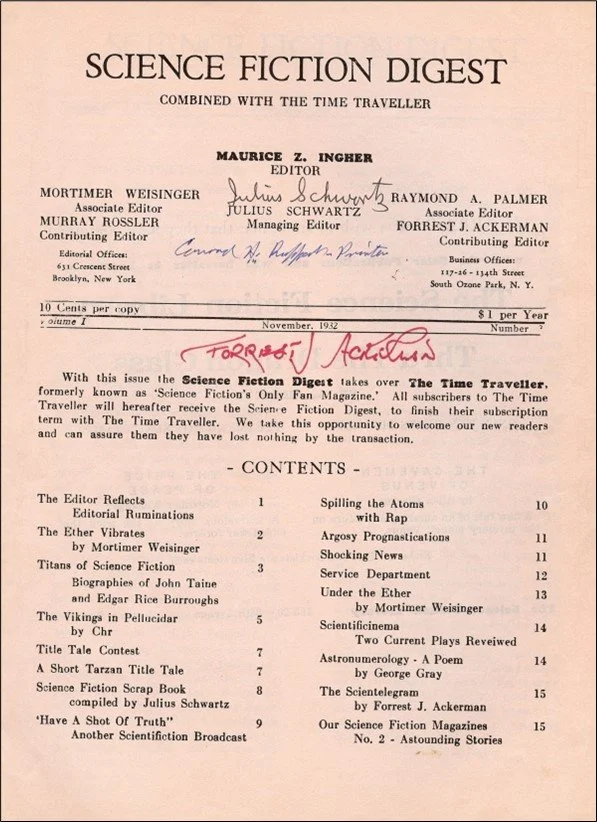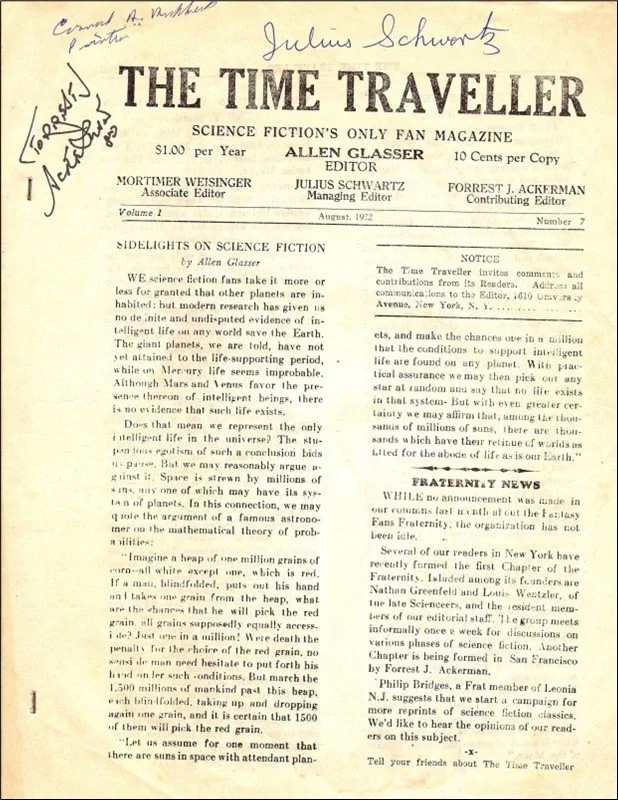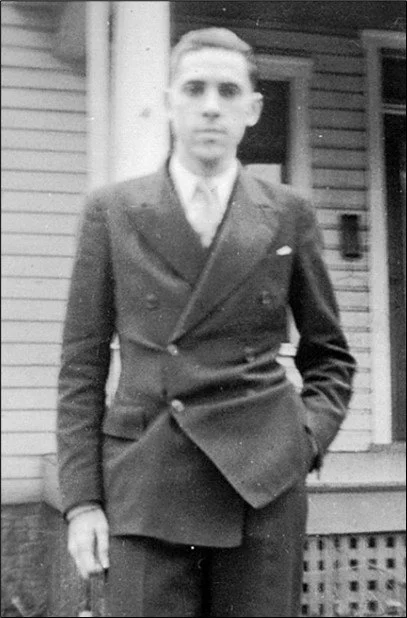Obituary: In Memorium
Conrad H. Ruppert
and the
World of Tomorrow
by John L. Coker III
Conrad H. Ruppert (1912-1997) was an early science fiction (SF) fan who made numerous and significant contributions to sf fandom during the mid-1920s through the early-1940s, but he will probably best be remembered as a photographer and provider of printing services.
Ruppert described as ‘the thrill of a lifetime’ being able to witness the transformation of science and technology from when he first read of the marvels of television and rockets in the early scientifiction magazines in the 1920s, to the reality of watching a live broadcast of Neil Armstrong walking on the moon in the Summer of 1969.
“Connie” Ruppert was born on November 12, 1912, in Brooklyn, New York. As a boy, he enjoyed reading the adventures of King Arthur and Tom Swift. When he was ten years old, he was confined to bed with rheumatic fever and among the magazines provided by his mother was an issue of SCIENCE AND INVENTION. It was published by Hugo Gernsback and illustrated by Frank R. Paul. Connie experienced the sense of wonder which was to last his lifetime.
Science and Invention, August 1923
He began reading every issue of the magazine that he could find, and when he was twelve years old, he applied for a card which made him a SCIENCE AND INVENTION reporter. He wrote a number of articles for the magazine, several of which Gernsback published. Over the next few years, Ruppert spent a lot of time in the public library reading as much science fiction as he could find, especially the works of H.G. Wells and Jules Verne.
During 1929-30, Ruppert maintained an active correspondence with sf fans Raymond A. Palmer and Walter Dennis. As part of a campaign to promote a Science Fiction Week in 1930, Ruppert convinced newspapers in several major cities to run editorials in support of the idea. At about the same time, Gernsback was sponsoring a contest to recognize people for contributions to SF, and though Ruppert hadn’t even heard about the contest, Gernsback awarded him a second prize of $50.
Soon afterwards, while working as an assistant in his father’s bakery, Ruppert bought a small hand press. With his friend Donald Alexander, he formed ARRA Publishers (the name derived from the initials of their last names), with the intention of printing small booklets. They bought the rights to reprint A. Merritt’s ‘Thru the Dragon Glass’ and released it as their first publication. They soon published another booklet, “Wolf Hollow Bubbles” by David H. Keller, as Scientific Detective Series Number One.
In early 1932, Ruppert received a mimeographed copy of THE TIME TRAVELLER, widely-regarded as SF’s first real fan magazine. He contacted the editor (Allen Glasser), and after several meetings they agreed that Ruppert would begin printing the magazine, starting with the third issue (March 1932). Ruppert’s production values greatly enhanced the appearance of the fledgling magazine, which led to an increase in the number of subscriptions. It also attracted the interest of established writers who were inspired to contribute material to the magazine. Ruppert set the type by hand for several more monthly issues of THE TIME TRAVELLER.
It was during this same time that Ruppert and Schwartz established Solar Publications, and they issued two booklets: “The Cavemen of Venus” (by Allen Glasser), and “The Price of Peace” (by Mort Weisinger).
Then, Julius Schwartz, Mort Weisinger and Ruppert had a disagreement with Glasser and they departed. They soon began publishing SCIENCE FICTION DIGEST (which eventually became FANTASY MAGAZINE). The four people involved at the start of the magazine (including Maurice Z. Ingher, whom Ruppert asked to be editor) each contributed $25. to get things going. Connie came up with the name and soon they began printing and mailing copies.
During 1932-1935, Ruppert produced some of the finest periodicals in the history of SF. In performing his typesetting duties, Ruppert (for all practical purposes) was actually the editor, and he further contributed as a columnist and business partner. Ruppert also printed all eighteen issues of Charles D. Hornig’s monthly magazine, THE FANTASY FAN (September 1933 - February 1935), the quality of which so impressed Gernsback that he offered seventeen year-old Hornig an editorial position with WONDER STORIES.
Charles D. Hornig
First World Science Fiction Convention, July 4, 1939
Front L-R: Ray Bradbury, Leo P. Margulies
Rear L-R: Manly Wade Wellman, Mort Weisinger, Erle M. Korshak
Photograph by Conrad H. Ruppert
Conrad H. Ruppert in front of the shop where he printed “Roads” by Seabury Quinn, the Souvenir Journal for the first Worldcon, and “The Dawn of Flame”
Argosy All-Story, July 12, 1924
In 1933, Ruppert and Hornig decided to take a train trip from New York to Chicago to visit Walter Dennis and attend the World’s Fair, whose theme was “A Century of Progress.” When Ray Palmer learned about their plans, he came down from Milwaukee and they all spent a couple of days together.
It was also during 1933 that the people involved with SCIENCE FICTION DIGEST came up with the idea of doing a story about characters from different parts of the solar system, bringing them together at a central point. It was to be called COSMOS. Palmer undertook the project and changed the original outline. He had a character from a nearby star come to the solar system in order to fight the invasion that was coming from his system.
Multicolor letterpress used to print most issues of
Science Fiction Digest and Fantasy Magazine
Chandler and Price printing press used to print “The Dawn of Flame”
In 1934, Ruppert had an idea of creating a comic strip about a super-being, and he approached Clay Ferguson, Jr. (the artist who had drawn interior artwork and illustrated several covers for FANTASY MAGAZINE). Ruppert wanted a strip where he would supply character development and story line, and Ferguson would illustrate it.
The premise featured a young man from another solar system who fell in love with the princess of a planet. The king opposed this relationship and decided that the man’s punishment would be to be made immortal. The man and the princess were banished to the outermost planet, where they lived until she and their children died. Over time, he gained extraordinary strength and exceptional mental powers and went from planet to planet, doing good deeds.
Ruppert and Ferguson prepared a few strips to promote the idea, and Ruppert contacted the syndicates, but there was no response to his letters and they could find no publisher. After some time, they abandoned the idea.
The Time Traveller, Volume 1, Number 3, March 1932
Science Fiction Digest,
Volume 1, Number 3, November 1932
L-R: Mort Weisinger, Ed Weisinger, Julius Schwartz, Raymond A. Palmer
Connie remained active in science fiction, and attended meetings and regional conferences through the late-1930s, where he remained acquainted with such luminaries as H.P. Lovecraft, David A. Keller, Otto Binder, A. Merritt, Frank Belknap Long, Jr. and Raymond Z. Gallun and met aspiring writers such as Isaac Asimov, Robert A. Heinlein and Ray Bradbury.
In 1936, following the death of Stanley G. Weinbaum, members of the Milwaukee Fictioneers, with support from Schwartz and Weisinger, decided to issue a memorial volume. Palmer managed most of the production. Although Ruppert was busy with other obligations, he printed the volume at his cost on high quality paper, and sent the finished pages to Palmer, who bound them with fine leather into books with gold stamping.
In 1939, Julius Schwartz approached Ruppert about printing a souvenir journal for the first World Science Fiction Convention, which was to be held in July in New York City, and together they sold enough advertisements to raise the sixty dollars needed for the cost of printing. Connie produced a beautiful program book with a gold metallic cover and interior artwork by the Guest of Honor, Frank R. Paul. On the morning of the convention, Ruppert took his camera and stood outside of the hall with Julius Schwartz to photograph the professionals and notable fans as they arrived at Caravan Hall.
The Time Traveller, Volume 1, Number 7, August 1932
The Fantasy Fan
First Anniversary Issue, September 1934
Ruppert bought a linotype machine and started a printing service. He printed many types of jobs but was most interested in those having to do with science. He printed the early issues of ASTRONAUTICS, the magazine of the American Rocket Society, and this led to some printing for Willy Ley. And, for several years, Ruppert printed the circulars for Otis Adelbert Kline’s literary agency.
By the mid-1930s, other commercial opportunities made it increasingly difficult for him to donate time each month to typeset and edit the magazines. After FANTASY MAGAZINE’s Third Anniversay Issue, Schwartz took over as editor and William Crawford took on the printing responsibilities.
Clay Ferguson, Jr.
Souvenir Journal — Nycon
First World Science Fiction Convention
Metallic cover, glossy paper, color interior
It was during this same summer in New York City that Ruppert took extensive pictures at the New York World’s Fair, whose theme was ‘The World of Tomorrow.’ It was located in Flushing Meadows, just a short bus ride from where Ruppert lived, so Connie bought books of tickets and visited there more than twenty times. He once spent the day there with Julius Schwartz and Ray Bradbury. Knowing that his involvement in fandom was waning at the same time that a war in Europe was brewing, the utopian vision of the 1939 World’s Fair certainly must have seemed to Ruppert to be a bittersweet culmination of all of his efforts in SF over those past fifteen years.
After selling his printing business in 1941, Ruppert was drafted into the U.S. Army in April 1942. He received an honorable medical discharge fourteen months later. After returning home to work and raise his family, there was little time for Connie to devote to fandom, although he continued to read SF.
His passion for color photography led Ruppert to begin taking scenic pictures and making 16mm films, and in doing so, he preserved for future generations the vanishing images of Eastern Long Island. Over the years, Connie received recognition for his award-winning pictures and he enjoyed putting on photo exhibitions and giving slide shows in the public schools.
In 1989, thirty of Conrad H. Ruppert’s photographs of the 1939 World’s Fair were showcased in a book entitled ‘The World of Tomorrow’.
Julius Schwartz and Conrad H. Ruppert
New York, 1945
Then, amazingly, after a long hiatus, Ruppert attended the 50th Worldcon in 1992, where he enjoyed a reunion with Schwartz, Ackerman, Sam Moskowitz and others. This rejuvenated Ruppert, and he became involved in fandom again. During the last five years of his life, Connie renewed his written correspondence with long-time friends, assembled a complete set of his early publications, and began attending conventions and the First Fandom reunions.
In April 1994, Ruppert received the Raymond Z. Gallun Award from I-Con (Stonybrook University, Long Island, New York), and in May of the same year he had thirty-two of his photographs of the 1939 World’s Fair ‘showing science as a promoter and entertainer’ featured as part of the major permanent exhibition entitled ‘Science in American Life’ at the Smithsonian’s National Museum of American History, Washington, D.C.
Pioneering SF fan Conrad H. Ruppert set the highest standards as a founding father of small press specialty publishing, and after significantly influencing the birth and development of SF fandom, and experiencing a lifetime of living in the future, he died peacefully on August 28, 1997 at the age of eighty-four.
